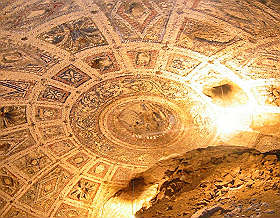 It was all over the news here in Italy last night. Apparently archaeologists in Rome have found the Lupercale on the Palatine hill.
It was all over the news here in Italy last night. Apparently archaeologists in Rome have found the Lupercale on the Palatine hill.
This is incredible news for anybody interested in ancient history.
The Lupercale is legendary in more than one way. For the ancient Romans it was the cave under the Palatine hill where the shewolf (lupa) suckled the two abandoned twins Romulus and Remus. Romulus and Remus then grew up and founded the city of Rome on April 21st, 753 BC. In a fight over leadership Romulus then killed Remus, and the city was henceforth called Rome after Romulus who became the first King of Rome. The Lupercale was therefore considered the very birthplace of Rome and was considered a sacred site.
Since the earliest times of Rome the cave was the centre of a very popular fertility cult. Each year Romans celebrated the lupercalia with great fervour. The lupercalia included some sacrifices inside the cave where the blood of the sacrificial animals were smeared in the faces of youngsters of noble families, but much more popular with the common people were the part of the festivitas outside the cave. To the applause of the onlooking crowds, the priests, luperci, dressed only in a goatskin throng, would chase young women around the entire Palatine Hill, whipping them all the way, in an attempt to induce fertility into them.
The lupercalia were so popular that not even the imperial edicts of the fourth century AD which outlawed all non-christian religion, could get the Romans to stop partying. The lupercalia continued well into the sixth century AD, to the dismay of the early popes.
 When Augustus established himself as the primo inter pares, in fact the first Roman Emperor, he built his house on the side of the Palatine Hill, very close to both the Lupercale and the place where legend will stood the little hut where Romulus and Remus lived initially. Roman nobility had for centuries preferred living on the Palatine, but the exact location of Augustus’ house was obviously an attempt to associate himself with the heritage of the city’s founders.
When Augustus established himself as the primo inter pares, in fact the first Roman Emperor, he built his house on the side of the Palatine Hill, very close to both the Lupercale and the place where legend will stood the little hut where Romulus and Remus lived initially. Roman nobility had for centuries preferred living on the Palatine, but the exact location of Augustus’ house was obviously an attempt to associate himself with the heritage of the city’s founders.
Later emperors built more and more sumptuous palaces on the Palatine, which has since given the English language the words “palatial” and “palace”.
The cave believed to be the Lupercale was found during the excavations of Augustus’ house on the Palatine. A sonde driven deep into the hill located a 15m deep cavity, and when a camera was lowered into the cavity, the image shown above resulted.
Nobody has been inside the cave yet, and the real entrance to the need still be located before a definitive identification of the cave with the Lupercale can be made. The location of the cave, the decorations and the fact that it is part natural, part manmade, is consistent with what is known about the Lupercale. The floor of the cave appears to be covered in several meters of debris.
Even after the entrance is found it will be many years before you and I will have a chance to see it, if that will ever happen. The Suprintendenza dei Beni Culturali in Rome suffers from constant underfunding compared to the massive volume of archaeological, artistic and cultural monuments they are obliged to protect, so it might very well end with a basic excavation, followed by a stabilisation of the cave which will then be left closed and inaccessible to the public. Let’s hope some funding will find its way to the Lupercale again.
Comments
One response to “Lupercale”
The Lupercale “I believe” may have been the Burdjan tribe as part of Bulgarian roots (Bulgar after ~330 AD). In 753 AD they would have been in Ahlat Turkey (then Anatolia), and thus migrated into Rome. This is after they founded Suvar (Samar,Sumer, Sumerians) and migrated to Ahlat about the time of the Noah’s Flood, or the Tower of Bable incident as referenced in biblical script. They spoke Akkadian. They originated in the country of Georgia about 15000 BC as the Imen Dynasties or the 7-tribes of Idel (Itil). Italy equals the “new Itil” or “Italy”. Burdjan also equals “the wolf soul”, which to me is very consistant with the Lupercale. I’ve been researching this name as a root to my name for 20-30 years. In American basketball we would call this a “slam dunk”. Also to be specific, this tribe celebrated Dec. 25 as “Nardugan” or the winter festival. I’m sure everyone can identify with this. The runic character for this is an “X” or, X-mas, being technically correct. I haven’t read any comments on the source tribe for the Lupercale yet and could use feedback from researchers with more information on this topic. Note that the Etruscans we shown to be Anatolian by DNA testing. Also note the Buriano Bridge (Ponte Buriano) is the one in the Mona-Lisa painting and in Tuscany ~1300 AD. This would allow 2 milleniums between these locations in Italy, and perhaps the tribal origin, but two completely different migrations. Also, I’ve seen some Etruscan art the has simular “diamondlike” patterns as exhibited in the Lupercale mosaics. I hope to here more and thanks for the web page. I’m in California, USA.